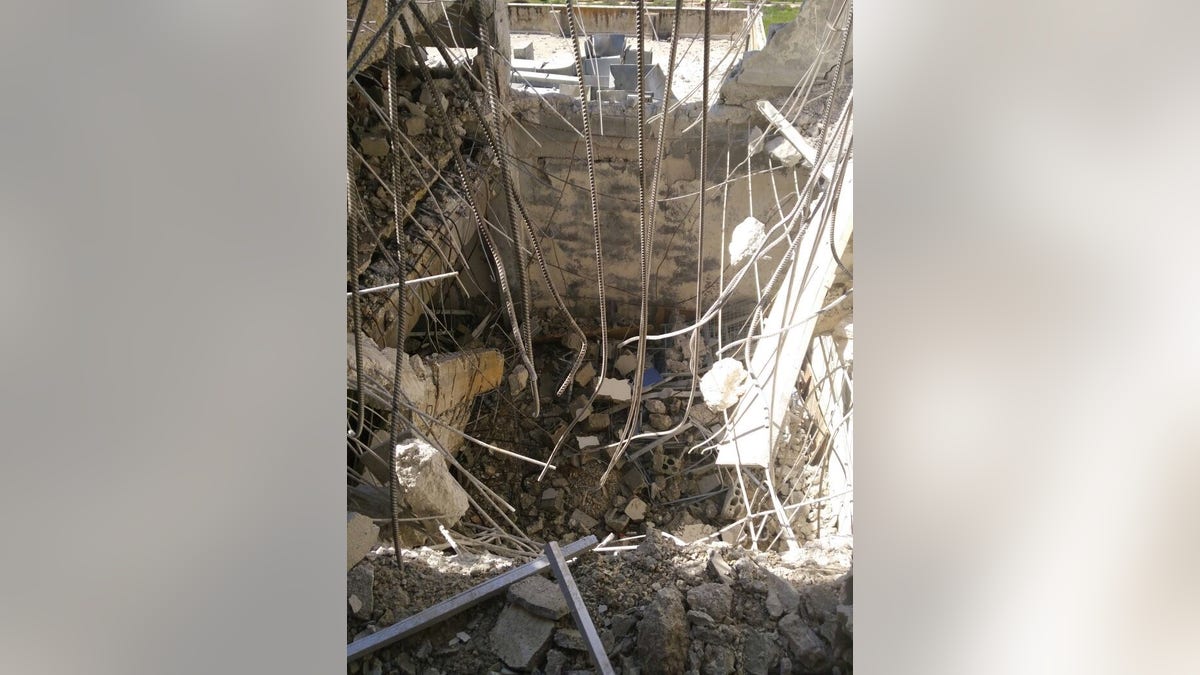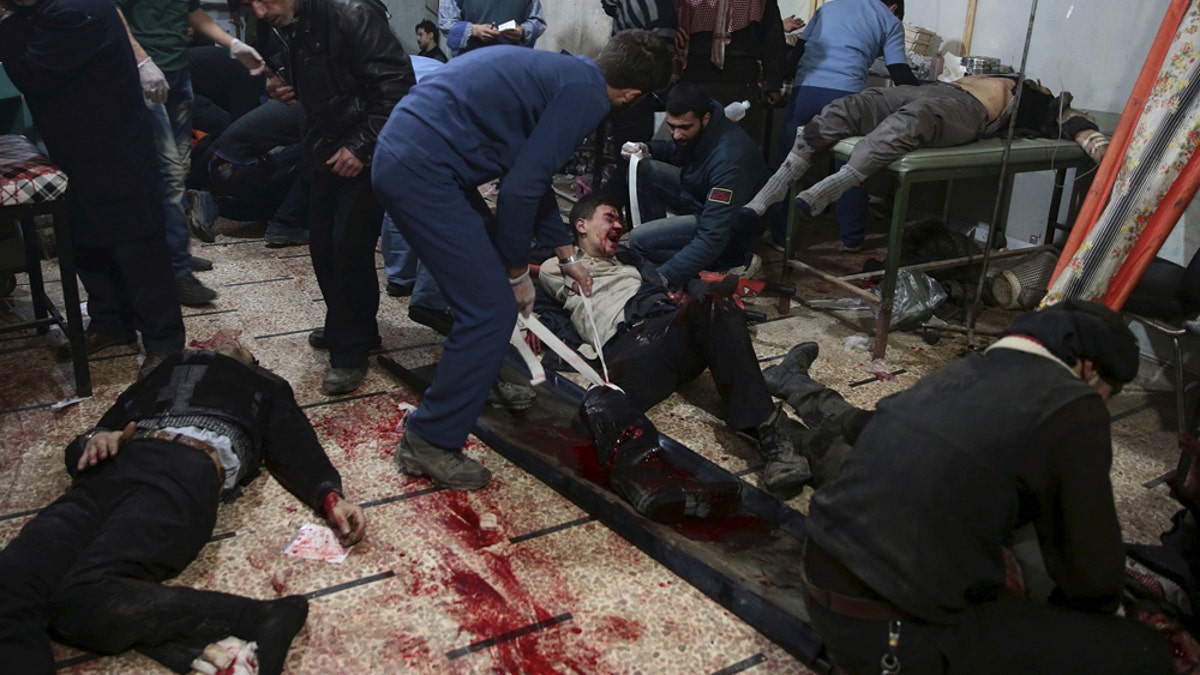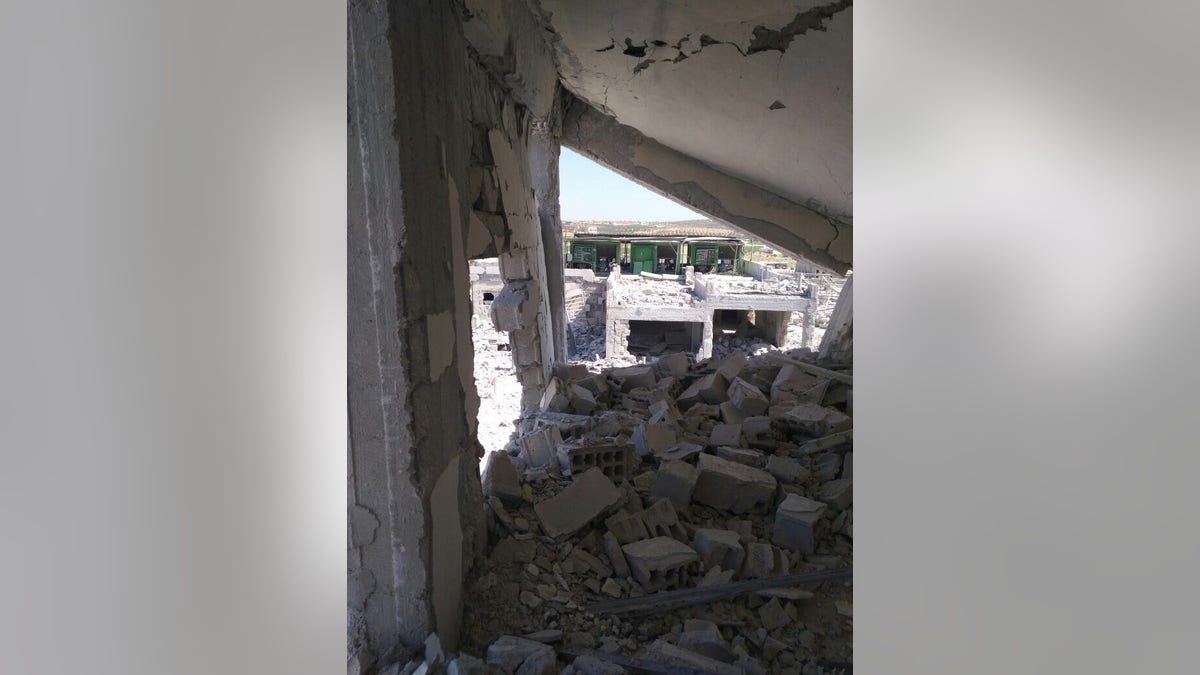
Rubble remains from an attack April 4 on a hospital in Khan Sheikoun, Idlib Syria. (Courtesy Syrian American Medical Society (SAMS))
Underground hospitals were a staple during World War II, to protect patients and medical personnel from aerial bombardment. Seven decades on, such secret, makeshift health care centers are crucial to the survival of Syrian civilians – and more are in the planning process as the 6-year-old war drags on and hospitals are targeted.
“There are no functional hospitals in and around Idlib,” Dr. Khaled Al Milaji of Syria told Fox News. “So we use whatever we can – basements of abandoned buildings, villas, little rooms and caves.”
There are currently two functioning underground medical facilities in opposition-controlled parts of Syria. Neither photographs nor disclosure of the locations are allowed. One is deep in the desert of eastern Hama and another is in southern Idlib.

A damaged operation room after an airstrike on the rebel-held town of Atareb, in the countryside west of Aleppo, Syria. (REUTERS/Ammar Abdullah)
The coordinates of a third, partly submerged facility in Hama was said to have been compromised last week and subsequently came under attack, with several witnesses saying chlorine-laden barrel bombs were dropped. The attack claimed the life of Dr. Ali Darwish, a prominent Syrian orthopedic surgeon who collapsed after refusing to leave his patient even as gas swarmed underground rooms. Fox News is told Darwish was taken out, but died on the way to the Turkish border for further treatment.
Milaji, who led the planning process to develop these hospitals from scratch, starting in 2014, said that the term “hospitals” is hardly the right word: They are “very small” and typically feature a small emergency area, a few beds for internal medicine, a couple of “emergency room” beds and one or two operating rooms.
But even a small facility takes at least 18 months of top-secret scheming and construction until it is ready for use. Sometimes they are built complete with corridors and rooms by carving them out of mountains and other times they are developed from existing structures.

Medics treat injured people inside a field hospital after air and missile strikes in the Douma neighborhood of Damascus, Syria, in 2015. The injured are taken to basements and shelters transformed into field hospitals run by medical staff who have stayed in the battered neighborhood of Damascus. (REUTERS/Bassam Khabieh)
According to data from the Turkish hub of the World Health Organization’s emergency response organization, that facility, which is built into a cave, in one month handled 1,600 consultations, 176 admissions, 150 surgeries and tended to 630 trauma incidences. Now all of that has been disrupted.
A study released by the American University of Beirut and published in “The Lancet” medical journal last month estimated that more than 800 medical personnel were killed in Syria between March 2011 and February 2017. Furthermore, there were almost 200 attacks on health centers in 2016 alone.
The apparent targeting of doctors and hospitals over the course of the conflict has led to a dramatic shortage of medical professionals and supplies, according to doctors on the ground. This has, however, meant that scores of other professionals – from teachers to engineers to lawyers -- have sought ad hoc medical training to be able to assist nurses and physicians as much as possible.
“The doctors want to work, but they don’t want to lose their lives,” Milaji stressed. “And they have to think about their families, too. There is no education and no schools here. They have almost all died or fled to Turkey.”
Those left are forced to change location around every 48 hours to avoid detection and, thus, death from a precision strike.

Hospital in Idlib, Syria following a bombing. (Courtesy Syrian American Medical Society (SAMS))
Milaji and a team of professionals have been in the ambitious process over the last 10 months of developing a much larger, fully fledged subterranean medical facility on the Syrian-Turkish border, which they hope to open in the next three to four months.
“We need to convince donors to support us and make sure we have enough doctors. Protection of our doctors is the most important priority,” he said. “We are now negotiating with electrical and mechanical experts to help get this finished.”
Following this week’s chemical attack on Khan Sheikhoun, in Idlib province, locals are preparing themselves for the notion that the worst is yet to come.
“We will also need to have tents for decontamination before we can bring the wounded to the clinic, otherwise our medical staff will be exposed and hurt,” Milaji continued. “And we are fortifying the walls so they are extra thick.”
Opposition-run hospitals are also disguised below still-standing buildings, where the above-ground floors are vacant and one or two below-ground levels are teeming with the wounded. But even so, the developers must ensure that the underground area has at least a few windows for ventilation. If attacked heavily from the air, the underground facilities have proven not to be immune to cracking and crumbling under pressure.
SYRIA CHEMICAL ATTACK: VICTIMS RUSHED TO TURKEY AS HOSPITALS OVERFLOW
One Syrian photographer and activist, who requested that only his first name of Mahmoud be used for safety purposes, said that multiple underground hospitals in the Aleppo countryside were decimated in intense fighting last year, as well as existing hospitals above the ground. He said that while some locals are desperately trying to get support for building underground facilities, they are often destroyed before their completion with Russian 20-foot-long concussion rockets.
Dr. Ahmed Tarakji of the nonprofit Syrian American Medical Society – which operates around 120 medical facilities and employs 1,300 workers in the war-ravaged country from the northern Turkish border to the southern Jordanian – said that while the buried medical clinics give those inside a sense of safety, they carry some risks.
“Even when attacked, the structure is weakened and there isn’t enough ventilation to deal with the gas that comes through,” he explained. “So these underground rooms end up becoming de facto gas chambers.”
And that, some anticipate, could lead to more toxic-type attacks as efforts to eradicate opposition groups, once and for all, escalates. Although Western powers and the majority of civilians in rebel-held areas have pointed fingers at the Syrian government as being behind the slew of chemical attacks in recent years, such claims have been staunchly denied by President Bashar Assad and his Russian allies. They say these were orchestrated by terrorist factions affiliated with the likes of ISIS and Al Qaeda.
But there is one thing that is certain: Hospitals are fast going out of business.
“Everyone is terrified. Hospitals are bombed after attacks to paralyze the ability to respond,” Tarakji added. “And with hospitals out of service, even a minor injury can result in death.”
